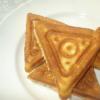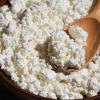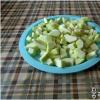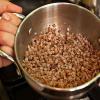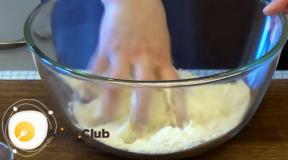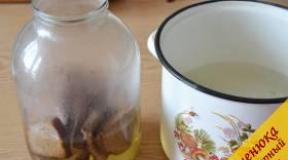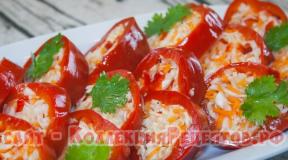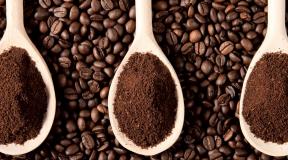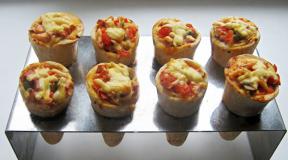Glass names. Heading “Bar equipment”
The famous wine critic Friedrich Siegel once remarked: "Without decent tableware, wine loses half of its charm. Drinking Burgundy from a liquor glass is like listening to a symphony orchestra with your ears plugged!" Let's not be deaf to authoritative opinion and try to figure out what's what.
The secrets of choosing glasses and wine etiquette are revealed by Evgeny Osipov, director of restaurants at the Marriott Royal Aurora hotel: - Any alcoholic drink requires special dishes. Even the most good wine, poured into a container that is not suitable for it, loses harmony. BUT right glass, on the contrary, emphasizes the aroma and taste of the drink. Usually wine glasses have a standard volume (190-230 ml for white wine, a little more, 240-255 ml for red) and a shape resembling a tulip bud: the bowl of the glass is wide at the bottom, slightly narrowing towards the upper edge, which prevents thin the aroma of wine.
At the same time, the bowl of a glass for white wine is particularly slender, more elongated upwards. Red wine likes to "breathe", so wider, "pot-bellied" glasses are used for it. Such a glass should not be filled to the top, but only a third. For rich and elegant fruit flavor for wines like Bordeaux, Rioja, a slightly elongated, egg-shaped glass is adopted. A red wine like Bourgogne, Barolo prefers spacious, rounded glasses. For tart wines - malaga, sherry - they choose glasses of a very simple, almost straight shape.
For champagne, there are two types of containers that are completely different from each other: flute - a tall and thin glass with a long stem with a volume of about 180 ml and a bowl with a very wide bowl with a volume of 120-270 ml. Kremanka is often used to create a pyramid of glasses. But in any case, champagne should be served with a glass on a long stem so that the hand does not touch the bowl and warm it - they drink champagne chilled. The shape of such a glass allows you to see the play of bubbles and enjoy this noble drink. And the narrow neck prevents the picturesque frothy cap from disappearing too quickly. When serving, especially dry champagne, glasses should be filled no more than half - to reveal the taste and aroma of the drink.

1. Glass for liquor. 2. Glass for whiskey. 3. Glass for grappa. 4. Beer glass. 5. A glass of liquor.
The volume and shape of the glass can be calculated so that they will exactly match the bouquet of a particular grape variety. The lightest and subtle flavors- the smells of fruits and flowers - rise to the edges of the glasses. The middle is usually filled with green plant aromas. The heaviest odors remain at the bottom. Often the wine is agitated or washed on the inside of the glass, which increases the evaporation area, and with it the intensity of aromas.
The approach to beer has also changed. Now all over the world, along with the traditional mug, they use both a tall beer glass and a glass with a stem in the shape of a tulip. All types of beer containers are suitable for this drink in the same way. The choice is due to individual taste. Now about stronger drinks. The traditional vodka glass has become more elegant - the glass narrows to the middle, and then expands upwards. But strong straight stacks are also relevant. A small liqueur glass (30-60 ml) is called a pony and is served for drinking liqueurs in pure form. It looks like a white wine glass, only smaller. Whiskey - both with ice and in its pure form - is drunk from low, "stocky" glasses "old fashion" (literally - "old-fashioned"). The thick bottom of the glass allows you to maintain the required temperature of the drink. In the same glass you can serve liqueurs and cocktails based on them.

6. Martini glass. 7. Glass for red wine. (cabernet sauvignon, merlot, barbaresco). 8. Glass for brandy, cognac. 9. A glass for white and fortified wine (Tokay, Riesling).
A small tulip-shaped glass is recommended for V.S.O.P. cognac, young armagnac, brandy, calvados, rum. Its shape and size bring out the subtle aromas of caramel and fruit, and soften the pungent strength of the alcohol. XO cognacs and mature armagnacs should be served in glasses of small volume, with a rounded bowl base and a narrow neck-top.
Cognac is poured one third, to the widest part of the glass, so that all the aroma is concentrated at the narrow neck. The glass should be warmed with the palm of your hand. Juices, carbonated and cold drinks, as well as mineral water should be served in a collins - a glass with a volume of 300 to 420 ml, usually slightly expanding upwards. Or in a strictly cylindrical highball, with a volume of about 240 ml. Enough interesting shape for an Irish coffee glass, it is a tall, straight cup on a leg with a small handle. It also serves other hot drinks.

10. Champagne bowl. 11. Champagne glass. 12. A glass for fortified and red wine (Tokay, Barsak). 13. Glass for white wine (chardonnay, sauvignon).
And finally - a few tips for beginner epicureans. Always hold a wine glass by the stem. Excess heat will prevent the wine from giving off aroma, and you from fully admiring its playful shades. If after serving white wine you have no opportunity to change glasses for red wine, rinse the containers mineral water. Never pour white and red wine into the same glass.
Pay attention to the color of the surface of the wine poured into the glass. If the surface of the wine is painted in warm colors (yellow, orange, gold), then this wine is aged. If the tones are cold (blue, green, steel) - young. Do not store glasses near tea, coffee and herbs. Any extraneous aroma will leave its mark on the glass, and therefore on the drink. After the glass is washed, be sure to wipe it with a dry towel. Then there will be no smudges on the glass. If you're dining in a restaurant that serves a variety of wines during your meal, don't be surprised to see a row of glasses in front of you. The usual sequence is from right to left.
BY THE WAY
Psychologists say that not only the taste of the drink, but also the mood of a person depends on the right glass. Transparent glasses evoke a feeling of purity, lightness and openness. They are good for a gift, especially in conflict situations when you intend to inspire affection and trust. Glasses made of colored glass should not be given to people who are too sensitive, and glasses with a pattern are suitable for people who are funny.
True connoisseur of this noble drink- Friedrich Siegel - once remarked that without decent tableware, wine can lose its taste qualities and properties. That is why it is worth paying special attention to what types of wine glasses exist and what are their fundamental differences.
Physiology of taste
On the surface of the tongue is a large number of receptors responsible for perception different flavors. So, for example, at the very tip of the tongue there are nerve endings that perceive sweet taste, closer to the larynx are receptors that transmit bitterness, but salty notes are effectively perceived by the middle of the tongue.
Oddly enough, but it was precisely with these physiological characteristics of a person that various types of wine glasses were developed, since this drink is amazing combination taste and aroma. So, in order to fully appreciate the exquisite aroma of red, special glasses of a wide and open shape were created, and narrow and long glasses allow you to appreciate the fullness of the free flow of this drink.
A little history of the origin of glasses
Glasses for which allow you to appreciate the noble taste and aroma of this drink, first appeared in France in the 18th century. Currently, a glass is a container with a capacity of 125 to 150 ml, which can be cylindrical or pear-shaped. In addition, there are wine glasses designed for which they have the shape of a vase.
The correct placement of glasses on the table is also of great importance. So, in relation to the serving plate, wine glasses should be on top or to the right.

Relationship between glass and taste buds
The perception of the taste and aroma of wine is greatly influenced by the very shape of the glass, the thickness of its glass, as well as the quality of workmanship. located on the surface of the tongue, contribute to one or another perception of the drink. So, for example, wine, which contains sour notes in its aftertaste, is desirable to serve in glasses with a narrowed top. In this case, the drink will not be able to get on the sides of the tongue, which means that the wine will immediately be on the throat.
But "Chardonnay" should just get on the receptors, which are located on the sides of the tongue. It is for these purposes that it is desirable to use glasses with a wide edge. The salty taste of noble drinks is felt by all parts of the tongue, so almost any type of glass can be suitable for specific types of wine with a characteristic taste.
Types of glasses for red wine
The taste features of a noble drink are revealed only in properly served dishes. As a rule, red wine is served in fairly large and wide containers, the edges of which taper at the top. It is these glasses that are able to reveal a full bouquet of aromas and flavor blends.

These are the most common types of wine glasses that are found in almost every connoisseur of this drink. In such dishes, it is desirable to serve "Merlot" or, since the edges of the glass tapering at the top eloquently express the whole bouquet of aromas and taste characteristics drink.
The Bordeaux glass is distinguished by a large and wide bowl, which helps to fully reveal taste features and fragrant blends of exquisite drink.
wine culture
Today there is great amount wine glasses of a wide variety of shapes and volumes, which, in turn, are designed for the most various kinds noble drink and even grape varieties.
Of course, it is rather difficult to understand this assortment, since modern manufacturers of bohemian products, in their pursuit of perfection, surprise buyers with absolutely incredible shapes and bizarre curves of containers designed for tasting a noble drink. Perhaps nothing can emphasize the taste so exquisitely as well-chosen and elegant wine glasses. Types of "bohemia", for example, are not just for consumption, it is a pleasure to drink a noble drink from such glasses.

Nevertheless, among all the variety, one can trace some basic directions and shapes of glasses that have common features and are characteristic of a particular type of wine.
Wine glasses: types, photos
There are several most common forms of wine glasses, among which the following are worth highlighting:
- The tulip shape is the most common and versatile.
- Ball - is a very peculiar form of a wine glass, which is not so common, but is very much appreciated among true gourmets.
- Lira - this form of glass is not popular among tasters and admirers of the noble drink, but is of particular interest.
Glasses for wine (black or colored types) can be completely bizarre in shape. In addition, canteens accept the use of completely different interpretations of dishes for this drink.

Aesthetics of taste
In order to maximize the quality of the drink and its taste, you need to follow some recommendations, which, in turn, will help you enjoy the wine. So, for example, the leg of a glass should be clasped with five fingers and in no case should you stick out your little finger - this is a sign of bad taste. Holding the glass with three fingers (thumb, index and middle) is also not recommended.
Before you take a sip of a noble drink, you need to inhale its aroma - this will allow you to get a primary idea of the taste of wine.
From this it follows that a glass of wine must be held by the leg with all fingers. Particular attention should be paid directly to the bowl itself - it is unacceptable to clasp it with your hand, as this will provoke the heating of the drink, and consequently, the deterioration of its taste.
Instead of total
Of course, the right glass has big influence on the drink itself and its taste. One of the main classifications of wine glasses is the type of this noble drink. So, there are special glasses for white and red wine. In addition, there are also peculiar universal glasses for wine, the types of which do not have significant differences from each other. As a rule, they are intended for tasting table varieties of the drink.

True admirers of this drink adhere to special rules consumption and tasting. Moreover, only they can meet truly unique containers that allow not only to fully appreciate refined taste of this noble drink, but also get a lot of pleasure from the tasting process itself. Wine glasses - colored, black, bohemian, etc. - are designed to truly plunge into the atmosphere of exquisite pastime with a bottle of French or Spanish Cabernet.
It is worth noting that professional tasters use for appropriate purposes a specialized glass approved by GOST. The development of this container belongs to the well-known company Riedel, whose products are popular in many countries of the world and are considered the standard of quality.
An incorrectly selected glass can significantly distort the taste of a noble drink, which is why for tasting fine varieties it is necessary to select the appropriate dishes that will help you fully appreciate the qualities of a particular type of wine.
The use of cutlery is a whole science called table etiquette. It is easy to use a variety of forks and plates. Their purpose can be guessed intuitively. In most cases, this is not difficult. But choosing the right glass for cocktails, based only on intuition, is quite difficult. After all, there are more than a few hundred types of these products. Glasses differ in glass thickness, shape and are intended for the corresponding drinks.
Why are glasses needed?
In ordinary life, a person does not think about which vessel to drink a drink from. However, in order to get true pleasure from a cocktail, it should be served in a specially designed glass.
Quite eloquent was the statement of the famous wine critic Friedrich Siegel. Once he noticed that wine without worthy dishes loses half of its charm. Drinking Burgundy from a glass not meant for it is like listening to a symphony orchestra with your ears plugged.
Useful information
In the eighteenth century, glasses first appeared in France. They were used only for wines. Incidentally, translated from French the word "glass" means "jar". Today's vessel has evolved somewhat. Now the glass is a container (125-150 ml) of an elongated, cylindrical, somewhat pear-shaped shape or takes the form of a vase.
Distinguishing a cocktail glass from a glass is quite easy. The capacity of the latter, as a rule, is 200-250 ml. It is used for mineral water or fruit. a vessel without a leg, cylindrical or expanding upwards.

When serving, glasses are placed to the right of the plate and on top. Observed next order: Furthest is the Vessel that must be used first.
Varieties of glasses
It should be understood that vessels are made in various shapes for a reason. It is it that allows you to maximize the disclosure and fixation of the aroma and taste of the contents. An incorrectly selected glass can upset the necessary balance.
AT modern world The following varieties of this utensil are accepted:
- glasses for champagne, sparkling wines;
- snifters (designed for ;
- wine glasses;
- glasses for vodka and liquor;
Consider the last category of vessels.
Variety of glasses
Glass of Irish coffee
Capacity (Irish Coffee Glass) resembles the shape of a tulip. Distinctive features wine glasses are short stem and thick handle. The latter is made of heat-resistant glass. This allows the product to be used for hot drinks. That's what the glass is for. It is mainly used for mulled wine and grog drinks. Suitable vessel for coffee cocktails. It is also used for drinks with the addition of ice cream. Irish coffee is served in such a container.
The volume of the vessel is 240-320 ml.

Glass of old fashion
Vessel (Old Fasioned) has a rectangular shape. It has a thick bottom and walls. Its volume is from 100 to 320 ml. Today, such a vessel is not as popular as it used to be. Its main purpose is to serve strong alcoholic beverages. Usually it's whisky. However, the drink is served not in its pure form, but with the addition of ice. The thick walls of the glass prevent the rapid melting of the latter.
This vessel has an amazing history of its creation. As you know, cowboys in the Wild West often "fired" bottles. The bartenders carefully collected the remaining fragments. Glasses were made from the bottoms. According to this likeness, an old-fashioned glass is made today. It is very durable and practically does not break.
Pilsner glass
Its other name is sling. This is one of the options for a highball glass. It has a more glamorous look. This vessel got its name after the invention of the cocktail ( classic version) "Singapore sling". Product volume - 200-300 ml.
Widely used cocktail glass:
- "Sling" (various variations).
- "Sex on the Beach"
- "Sweet Contrast"
- "Banana Daiquiri"
Glass features
These vessels can radically change the perception of the taste and aroma of the drink. Indeed, depending on the shape of the glass, the first sip affects certain taste buds.
In addition, special attention should be paid to the sonority, purity, strength of the product. Any bubbles, chips, cracks, turbidity - this is a real marriage for this vessel. A professional glass should have a number of features.
The most important thing to pay attention to is the composition and quality of the glass. Modern glasses are made from the following types:
- ordinary glass;
- synthetic;
- smooth crystal.
Synthetic glass is obtained from plastic raw materials. These glasses differ high strength. At the same time, their surface is quite sensitive to any extraneous influences.

Crystal glass contains lead. It is this component that gives the glasses improved properties. Thanks to lead, they are somewhat similar to crystal. These glasses are transparent, sparkling and durable.
Conclusion
Psychologists say that the shape of the chosen glass not only contributes to taste sensations, but also can significantly lift the mood. The use of transparent glasses in a person is associated with a feeling of lightness and purity, openness. Such vessels are perfect for a gift, especially in conflict situations. This gift will inspire trust and favor. Glasses made of colored glass are not suitable for especially sensitive people. Persons with a good sense of humor will like vessels with a pattern.
It is not so easy to navigate all types of cutlery and their use, as table etiquette requires. And if you can still somehow deal with plates intuitively, then with glasses everything is much more complicated: after all, there are about several hundred of them, and all of them are different in shape, glass thickness and are intended for certain drinks.
AT Everyday life we rarely think about which glass or glass to drink this or that drink from. But, wanting to get real pleasure, we realize that any drink must be served in a special glass. After all, even the most exquisite wine, served in a vessel that is not suitable for it, loses its peculiarity, and a properly selected glass only emphasizes the taste and aroma.
1. A glass of champagne flute (glass flute) used to serve refined champagne wines. In a classic high glass narrowed to the top, the drink foams well, “plays” longer and does not exhale so quickly. A glass of 200-300 ml is filled strictly 2/3. Champagne can be served with all dishes, from appetizers to dessert, always chilled to 6°C.
2. Do champagne bowls wide mouth, so the carbonation of the drink quickly disappears. It was popular in the 30's and 40's. XX century, but now lost its popularity and is mostly used at events where they build towers from champagne glasses, as well as for serving the Daiquiri cocktail. The volume of the glass is 120-200 ml.
The champagne bowl was common in the 30s and 40s. 20th century, but has now lost its popularity.
3. Red wine is more enjoyable when served in squat, rounded, wide-bottomed glass. A large area of contact with air contributes to the saturation of the drink with oxygen, a more subtle and full disclosure of the bouquet. The volume of the glass is about 260 ml. Red wine is served with duck, geese, beef, pork, lamb, game, as well as dessert. Dry and semi-dry red wines are drunk room temperature, about + 18 ° С, sweet and semi-sweet - slightly chilled.
4. For white wine use glasses with a bowl tapering upwards of small volume(210 ml) - thanks to frequent refilling, the drink in such a vessel will always be cool and fresh. White wine is poured into 2/3 glasses, served chilled to 10 ° C with fish, poultry, chickens, turkey, veal, as well as dessert.
5. Universal (tasting) glass similar in shape to a white wine container, but has smaller size(150-160 ml). It fills no more than a third and is quite suitable for port, white and red wine.
6. Small (25-60 ml) glass triangular shape with a short stem designed to serve pure liqueurs, but can also be used for cognac. The liqueur in it should be served chilled to 10°C.

7. In glass with a volume of 80-100 ml called "mader glass" or "port voice", it is customary to serve sherry, vermouth or fortified wines. This classic triangular-shaped glass with a graceful curly stem is only half-filled with a drink chilled to 10°C.
8. Glass "snifter"- with a thick bottom and a powerful short leg, strongly tapering upwards - designed to serve brandy, cognac, armagnac and calvados in its pure form. The vessel fits perfectly in the palm, from the warmth of which the drink warms up and reveals its taste and bouquet. Therefore, drinks should be served at room temperature and drunk in small sips, savoring the taste. The volume of the snifter is 260-390 ml, but you can only fill it up to the edge of the wide part of the glass, that is, no more than a quarter.
Drinks should be served at room temperature and drunk in small sips, savoring the taste.
9. In glass of rock, or, as it is also called, "old fashion", serve whiskey - both in pure form and with ice. The glass has a rectangular shape with thick walls and a bottom that slow down the melting of ice. A vessel with a volume of 100 to 320 ml is half filled.
10. Small, straight shot glass with a thick bottom, volume 40-60 ml, intended for strongly chilled strong alcohol in its pure form (for example, vodka) and for strong layered cocktails of small volume, designed for 1 sip.
11. Tall glass widened to the center designed for beer, but can also be used to serve various cocktails. The volume of the vessel ranges from 220 to 500 ml. The colder its contents, the better.
12. Beer mug has a larger volume than a glass - from 250 to 1000 ml.

13. Tall highball glass 150-300 ml, with strong walls and a thick bottom, expanding at the neck, used to supply water, soft drinks and some types of cocktails.
14. Collins - a tall glass with thick straight walls and a bottom, with a volume of 230-340 ml, is the most popular glass for strong alcohol mixed with soda and ice, as well as for large-volume cocktails with ice (Mojito, Long Island Ice Tea).
15. Universal glass-tumbler with a volume of 260-320 ml, with thickened walls and bottom, suitable for both cocktails and strong alcohol with ice, used for serving crunches, egg legs, aperitif cocktails, flip cocktails.
16. Martini or cocktail glass, - a triangular-shaped glass with a wide neck and a long, thin stem, thanks to which the cocktail does not heat up. It is ideal for most chilled medium-sized cocktails without ice, but is completely unsuitable for pure drinks (including martinis, despite its name). The volume of this glass is 90-280 ml.
17. A glass with a volume of 200-250 ml on a thin long leg, very narrow at the base and very wide at the neck, designed for Margarita and its variations, as well as for frozen drinks. The edges of this glass are usually decorated with a sugar border.

18. Hurricane - a long glass in the shape of a tulip on a short curly leg volume 400-480 ml - designed specifically for serving tropical cocktails type " Blue Hawaii or Pina Colada.
19. Glass of unusual shape (grappaglass) intended for grappa, italian alcoholic drink infused with grape pomace.
Pus cafe (pousse cafe) is layered cocktails, the individual components of which are selected in contrasting colors, are arranged in layers and do not mix with each other.
20. A small glass with a thick stem used for cocktails of the sour group, which differ sour taste thanks to the content of citrus juices in them.
21. In a small narrow glass with a volume of 50-120 ml pousse cafe is served — layered cocktails, the individual components of which are selected in contrasting colors, arranged in layers and do not mix with each other.
22. Irish coffee (irish coffee)- a tulip-shaped glass with a short stem and a thick handle made of heat-resistant glass with a volume of 240-320 ml - designed specifically to serve hot drinks such as mulled wine, grog or Irish coffee, but also suitable for coffee cocktails, drinks with ice cream.
23. In bowls with a volume of 100-180 ml serve hot punch, filling them three-quarters full.
Of course, this is only a small part of the huge number. existing species glasses, wine glasses, glasses, glasses and shot glasses. But this minimum is quite enough to correctly present this or that drink and show its best properties.
The number of dishes used for table setting is quite extensive. In addition to cups and plates, this group includes glasses and glasses , used to serve alcoholic and non-alcoholic beverages. Each of them has a special shape and is designed for certain groups of drinks.
A bit of theory
Glasses are all types of thick-walled glass vessels that are used to serve drinks. Wine glasses are a group of glasses with a tall thin stem. Glasses - small glasses on a thin leg, intended for alcoholic beverages. Stacks or shots are small glasses without legs that are used for the strongest alcoholic drinks.
The use of a high leg on certain types of glasses is necessary to move the warm hand away from the container with the drink. This is especially important for alcohol, the heating of which will negatively affect the taste. Such vessels allow prolonged contact with the hand. They are served low alcohol drinks, which are held for a long time on a canopy and are used in small sips. Holding the container by the leg, you can drink the drink chilled for a long time.
Glasses and glasses differ in volume. There is a rule: what stronger drink, topics in smaller dishes he is served. From large containers, the drink is consumed in small sips and stretched for a long time. Alcohol served in piles or shots is drunk in one gulp at a time.
Manufacturing materials
Glass or crystal is mainly used for the production of glasses and glasses. These materials are transparent, although they may have different colors that reduce these properties. Such dishes look aesthetically attractive, but do not withstand mechanical shocks. Crystal containers are more expensive. Outwardly, they are distinguished by the presence of a more intense luster, which is due to the addition of lead to the glass composition.
Crystal requires special care. It is recommended to wash it by hand, not using a dishwasher. In addition, to ensure a good shine, it is better to use soft water. After washing, it is better not to leave the glasses to dry naturally, but to wipe them dry with a linen cloth.
As for the care of glass and crystal, it should first of all be noted that washing under hot water is inadmissible. These are brittle materials that can crack due to a sharp temperature drop. It is also forbidden to pour hot drinks such as tea or coffee into them. From contact with boiling water, the container will in most cases burst, of course, unless it is made of thick or heat-resistant glass, which is rare.
The cheapest glasses and goblets are made of plastic. This group also includes disposable drinkware, which is usually used in the field for picnics, fishing or hunting. There are also glasses made of more durable plastic, which are reusable. Their use when serving a full table is considered bad manners. Such containers are more suitable for a picnic. Their advantages include light weight and resistance to breaking. All polymer products are made from food-grade plastic, so they are completely safe. They are more intended for the use of soft drinks, since the lack of the correct shape and chilled surface can not change the taste of strong alcohol and cocktails based on it for the better.

What are glasses and goblets
Almost all glasses and glasses are designed for drinking only one or several types of drinks. It is worth noting that wrong combination containers and drink in most cases will negatively affect the taste, which even an unprepared person who does not claim to be a sommelier or a true connoisseur can feel certain types alcohol.
Water glass is one of the most capacious containers, which is designed for a volume of 850 ml. Although it is very large, it is not designed to be completely filled. It is enough to pour a third of water, which will be quite enough for a person sitting at the table. It is filled with ordinary table or mineral water. Do not pour juices into it, as well as soda, as this will be a gross violation of etiquette. Other glasses and glasses are provided for these drinks.

Red wine glass has a rounded shape and is mounted on a high leg. It is wide in the middle and narrows to the neck. Its volume ranges from 140 to 180 ml. Sometimes you can find larger containers. Such glasses belong to the category of wine glasses. Wide capacity provides large area contact of the drink with air, which allows oxygen to saturate the wine. This improves its taste and allows unnecessary odors to disappear, which the liquid can absorb while in a corked bottle, which is not uncommon during long exposure.

Glasses for white wine different from those used for red wines. Such containers have a high leg and an elongated shape. Their volume is much smaller and ranges from 100 to 150 ml. It is believed that a thinner container allows you to better open the taste of white wine.

Flute glass is a container stretched upwards, even more than a form for white wine. Its volume is 200 ml, but this is not a strict rule. It is used to serve champagne. It is believed that a tall glass narrowed to the top improves the foaming ability of sparkling drinks. Such a container is filled to two-thirds of the volume. AT expensive restaurants before serving drinks, the flute is pre-cooled to 6°C.

glass saucer also used for champagne. It is a low capacity on a high leg. Its volume rarely exceeds 200 ml. Such containers were invented 300 years ago specifically for champagne, which in those days was less sparkling. modern drink different from its original version, so the outdated glass does not reveal the quality well sparkling wine. In this regard, saucers began to be used for various cocktails.

cocktail glass It is a cone-shaped container on a high leg. This glass has a volume of 150 ml. It is used to submit alcoholic cocktails without adding ice.

Margarita glass has a specific shape. This container holds 200-250 ml. Its base is similar to a vessel for white wine, which in the middle begins to expand greatly. Margaritas are used to serve cocktails with ice.

Hurricane glass one of the few containers, the volume of which is equal to glasses of water. The capacity of such glasses is from 400 to 800 ml. They are used to serve tropical cocktails. The volume of liquid actually poured into them is much lower, since the vessel is filled to a large extent with ice and pieces of fruit.

Glasses and goblets for cognac have a volume of 200 to 310 ml. They serve not only cognac, but also brandy. They have much in common with red wine glasses, although they are more capacious and are located on a short stem. The drink is poured into them by a third of the volume.

Armagnac glass designed for the drink of the same name. It has a narrowing before the beginning of the neck, which enhances the aroma. The capacity of such a container is up to 240 ml.
Madeira glass is a small glass of only 75 ml in which sweet or fortified wines are served, consumed in large sips. Such containers have a rather thick leg.
Collins glass has straight walls. Its volume can be up to 340 ml. It serves refreshments. low alcohol cocktails with ice. Collins presents those glasses and glasses in which, in addition to alcohol, juices and mineral water can be served. Often, containers of this form, intended for soft drinks, have a colorful pattern.

highball- a wide glass with a narrowing near the base. Its volume is 270 ml. It is also used for soft drinks such as juices, compotes, punches and punches.

old fashion has a volume of approximately 180 ml, small deviations are allowed. It is designed to serve high-grade alcohol with ice. Usually rum or whiskey is poured into it.

Glass of latte has a volume of 150-300 ml. It is used for serving hot coffee drink. Its peculiarity lies in the manufacture of heat-resistant glass, so this container is not afraid of heating. This glass has a small bottom, and its walls gradually expand upwards.

Frappe represents glasses and goblets with a curved shape. Its volume is 160-250 ml. It is intended for thick cocktails based on cream and ice cream, as well as cold coffee drinks.

beer glass has the highest variety of volumes. There are containers with a capacity of up to 1 liter. They are filled with beer, as well as beer-based cocktails. Typically, such glasses have a bottom of medium width, and its walls first narrow, and then evenly expand towards the neck.

Glass of Irish coffee made of heat-resistant glass, as it is used to serve hot cocktails. It is a cross between a wine glass and a mug. Irish coffee and mulled wine are poured into it. The capacity of the glass is 180-200 ml.

faceted glass has almost universal application. Mainly intended for soft drinks. The faceted shape allows it to withstand impact and prevents rolling. Volume 200 ml.






